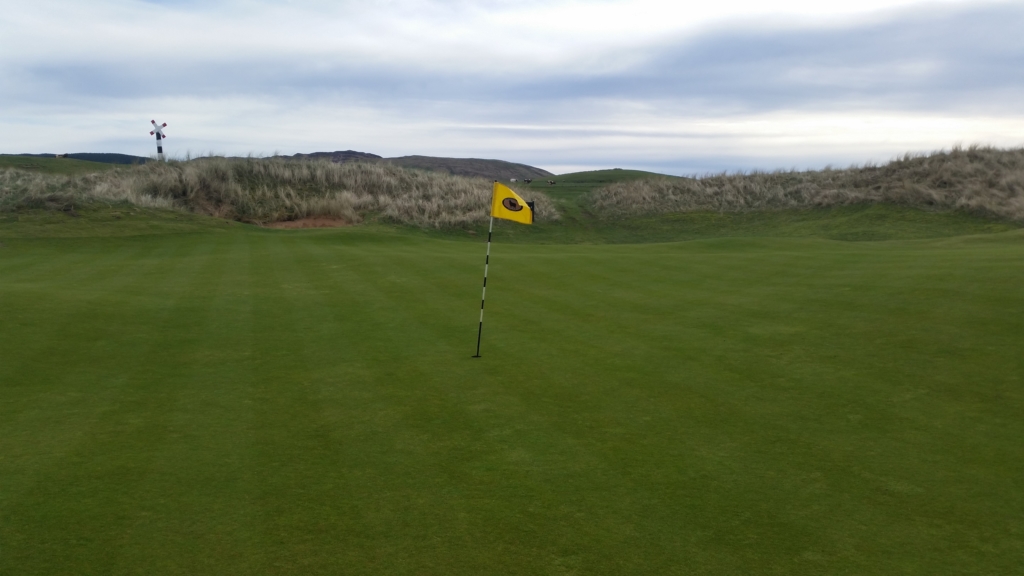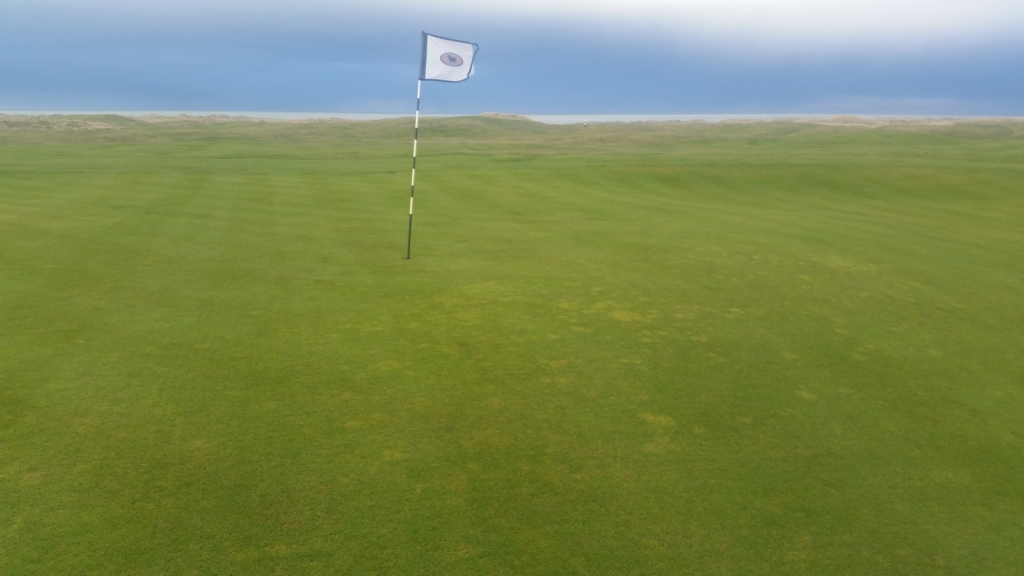Sorry, that was a pathetic pun to start a report with! It is pretty indicative of how we greenkeepers feel at this time of year, though. As the occasional burst of spring sunshine reminds us, the steady days of hard manual labour that typify our lives throughout winter construction season is about to give way to the frantic, but physically lighter, workload of summer. The stark transition from one season to the next – and the different jobs that come with them – is one of the aspects of course maintenance that we all enjoy. It definitely helps to keep our enthusiasm levels high.
Spring is a critical time for us on the West coast of Scotland because the months of April, May and the first half of June can be stressful to turf if the jet stream weakens and high pressure takes control. The high pressure tends to bring dry conditions and strong easterly or south-easterly winds (I dubbed it “the hairdryer” a long time ago!), which may allow for pleasant daytime conditions but also some cold nights. If turf is not in good condition going into a spell like this, it can be hard to scrape through this period without having to compromise surface speed in favour of plant health. If, on the other hand, all precautions have been taken to ensure that our swards are in perfect health, then this early Scottish “summer” can be a glorious time for golfers and greenkeepers to be alive.
To prepare for an early season dry spell such as this, we first have to make sure that our root system is in good condition. We analyse nutrient levels to ascertain where any deficiencies might lie and then aim to minimise the effect that this will have on plant health. Insect damage is a big issue at the moment, as several key products that we used to rely on have been removed from the market, with the consequence that we currently have no chemical control for leatherjackets. These larvae of the crane fly have a ferocious appetite for grass roots and can spend all winter munching through everything that we spent the previous summer trying so hard to gain. Although I have not visually spotted the signs of too much surface activity from them, we should assume that they will have done some damage beneath the surface. Therefore, we need to ensure that our nutrient levels are right and that the rootzones are prepared for accepting irrigation water.
Many of you will have heard me banging on about wetting agents before. These clever products are vital to ensuring that water we apply to the greens during a dry spell can penetrate the surface instead of running off high spots and settling into hollows. The technology that has gone into developing these products over the last few years is mind-blowing. We now have an arsenal of different wetting agents that allow us to choose a product that is tailored to suit the needs of every rootzone. My preferred product is designed to allow water to easily penetrate through the surface, but then holds it in a suspended matrix within the rootzone. It makes water available to roots for far longer than if gravity forced it deeper into the soil structure. Of course, this type of wetting agent is ideal for us at Machrihanish Dunes because our rootzones are relatively free-draining and oxygenated. If I were working on a rich soil full of fine particles, where surface drainage was considered more of an issue, I would probably choose to use a completely different product.
Cutting heights need to be carefully monitored at this time of year to ensure that plant health is not compromised. It is very easy to get carried away with the opportunity to provide exceptional surfaces for the first competition of the year (especially if this coincides with the Masters being on TV!). Plant health and root development can easily be compromised if we remove too much topical growth when the daylight hours and the opportunities to photosynthesise are still restricted. This is the reason why we raise the heights of cut on our greensmowers during the winter months – we need to keep more leaf area on the plant to retain the maximum number of photosynthesis receptors, to make the most of short periods of daylight. Whereas in summer, when we get up to 17 hours of daylight, we can get away with pushing the boundaries a bit further. Years of experience have taught us that all these things (and many more) need to be taken into account BEFORE the good weather catches us by surprise!

Simon, what can I do about the moss in my garden?
It is that time of year, isn’t it? Like all greenkeepers, I get it every spring from all quarters – like I have some magic cure to fix a lawn that has been neglected for months. The truth is that there is no magic cure to fix a moss infestation. But understanding the reasons why moss takes hold, and how you can avoid it getting a grip of your lawn in the first place, could save you hours of back-breaking work.
So here goes! Moss is a vacuum plant. By that I mean it will fill spaces left in the soil only when space is available for it to do so. It is not a strong enough competitor to fight against healthy grasses for valuable sward space. Just because we are turf “professionals” does not mean that we are immune from this – if you come and have a look at our greens, you will find moss in there too. If you study the greens closely though, it quickly becomes apparent that the moss only grows where the grass is under pressure and it therefore has the chance to compete. The picture below of the 2ndgreen is a classic example where the moss has grown in along the ridge. The mowers cut the grass shorter than we would like at those high points and it therefore lives in a perpetually weakened state.

One other thing that has occurred to me over the years is that moss infestations on links courses are always worse the further you go from the shore, leading me to believe that moss is even less tolerant to salt than turfgrass is. It is interesting because we have always been taught that sulphate of iron kills moss, but I have always been of the opinion that issues with moss ingression are worse on acidic ground, and we all know how acidic sulphate of iron is. Could it be that the iron merely shrivels the moss plant (in the same way as it shrivels the skin on your fingers when you touch it), but it is actually the high salt content in the product that kills it (and also causes all kinds of harm to beneficial mycorrhizal bacteria). Don’t take that as gospel, it’s just another one of my theories!!
A percentage of moss in the greens in early spring does not worry me one bit. A greenkeeping maintenance program is so intensive in April, May and June that we will quickly get this under control. Moss hates abrasion, so when we verticut, topdress, brush in that topdressing, aerate, and cut on a more regular basis once the growing season starts, it will soon give up the fight and die out. Then grass will flourish because it can photosynthesise more effectively during the summer months and because it readily uptakes the nutrients that we feed it with.
So, what can you, the gardener, learn from this? Well, you need to look at keeping the grass in your lawn healthy enough in the first place. If you have a full covering of healthy grass, moss will not have a chance to infiltrate. It helps if the lawn is well aerated, and if the ground has a healthy, neutral pH level. If your garden is laid on very acidic soil, applying some lime in late spring / early summer might raise the pH level enough to allow for an increased population of soil bacteria and worms. Lime can break down organic matter, feeding grass plants and reducing the depth of the organic layer that lies damp all winter. Damp ground provides an ideal growing medium for moss and for fungal infections that can damage grass plants.
I could spend ages writing a big program of works for you to follow in your garden, but that would be pointless because every individual piece of ground is completely different, and requires a different set of solutions for what may appear to be very similar symptoms. Golf courses are the same – it takes time to learn the exact nuances of the site and how the soil type, the weather, and many other things can influence our greenkeeping program. Once we have worked all this out, can we implement a plan that works specifically for us.
If I was to get really simplistic about dealing with moss, I would say that if you have it, then you should set about raking as much of it out as you can with a metal-toothed spring back rake and then planting good quality grass seed in its place. Once this seed has germinated, you should take care to look after your new grass by cutting it regularly at a sensible height. Preferably with a cylinder mower rather than a rotary. Whatever mower you have at your disposal, you should always lift and remove the clippings. Give thought to fertilisation – there are some great weed and feed products available from garden stores that contain a mixture of nutrients, a moss killer product, and some simple selective weed killers. At the end of the season (late September / early October) rake the lawn again with your metal spring back to remove any debris which has been deposited over the summer months. Broadcast some more good quality grass seed and aerate the lawn with a fork (stamp the prongs of the fork at least 6 inches into the ground and heave back, and then step back six inches and repeat until the whole lawn is done). For me, this is the one mistake that I see more people make than any other – if you want your lawn to be in good shape in spring, then you must put in the work the previous autumn. If any of these suggestions sound familiar, then that is because this program is exactly what we do out on the golf course. Once you know your soil and the intricacies of your site, greenkeeping is not rocket science. It is simply a case of applying the scientific knowledge you have learned, putting a site-specific program together, and getting stuck into the hard work. Making a success of your garden is exactly the same! Having said that, if you want any advice at any time about specific issues that you might have and you think I might be able to help, just come over and ask. I would far rather take 5 minutes to give you some answers than see you spend money that will not guarantee improvements!
Competition season is already here!
By the time you read this, the Winter league will be finished and the crazy Black Tee Open will be done and dusted. I hope we get a decent day for that, because if it is windy it could be attritional! The next noteworthy event on the calendar is the Kintyre Team Championship from the 22nd – 23rd of April, which involves a 4-person team playing one round at Dunaverty GC and one round at Machrihanish Dunes. At the time of writing, Lorna still has some spaces on her tee sheet for this fun event. So if you fancy participating, phone her as soon as you can on 01 586 810 058. We are going to have a barbeque and prize-giving after the golf on the Sunday of this event, so it should be a great sociable day.
Enjoy your golf in April. Hopefully the weather will be as good as it was this time last year!

